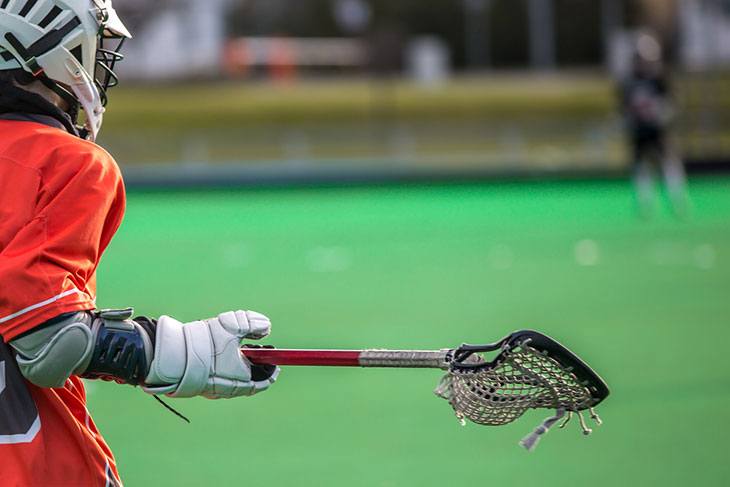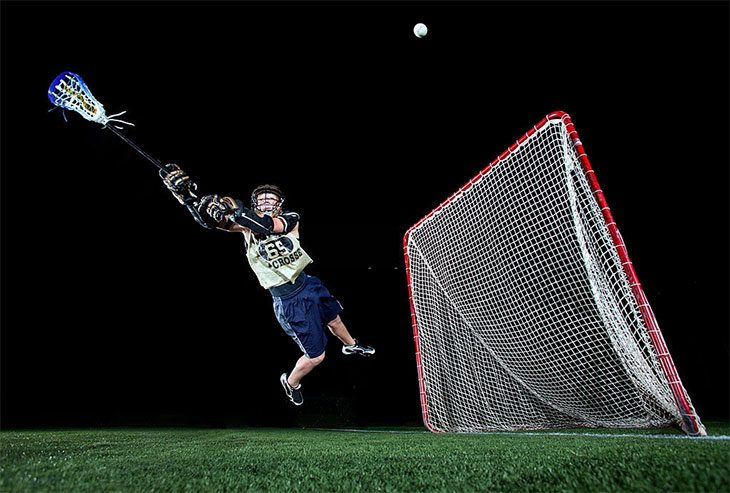Are you an avid lacrosse fan looking to understand better how the game works? Do you have aspirations of becoming a lacrosse player and don't know where to start? Then look no further.
This blog post is your ultimate guide to all things lacrosse. We will break down the rules, introduce key terms, explain basic strategies about how lacrosse is played, and provide helpful tips for first-time players.
More...
Take Away Key Points:
What Makes Lacrosse Special? All You Need to Know
Whether you are a diehard fan or a newbie looking for assistance, this blog post has something for everyone who wants a comprehensive guide on the fast-paced sport of lacrosse.
1. How does lacrosse work?

Lacrosse is a team sport that combines the intense physicality of hockey with the finesse of basketball.
Lacrosse is played using a lacrosse stick that a player carries. It's covered in mesh, which players use to pass and throw a small ball into their opponents' goal.
Each game consists of two teams with ten players who face off on an outdoor field about 110 yards long, with goals at each end.
2. How do you play lacrosse?
In lacrosse, two teams of ten players face off against each other on the field. The lacrosse aim of the game is to use your lacrosse stick to get possession of the ball.
You must pass a small rubber lacrosse ball into the opposing team's goal. The teams playing do this by running with or passing the ball or shooting it from a distance.
When defending, you must use your stick and body to prevent your opponents from scoring. Lacrosse is a fast-paced game with lots of physical contact, so players must be prepared to give and take hard checks while keeping their balance and trying to score.
Additionally, offensive players must work together to set up opportunities for shots on goal, while defensive players must stay aware of the other team's movements to anticipate their actions.
3. What are the rules of lacrosse?
The key elements of lacrosse are the same across both men's and women's leagues: two opposite teams of ten players battle on an outdoor field in an attempt to score more goals than the opposing team.
There are specific regulations, such as the size and shape of the field, the number of players on each team, and the type of gear used.
Each player must also wear protective equipment, including a helmet, arm guards, shoulder pads, and gloves.
Penalties can be issued anytime for dangerous or illegal play as the whistle blows.
4. What strategies should players use?
Lacrosse is a fast-paced game that requires quick thinking and strategic play. Players need to have the ability to read the game and anticipate their opponent's moves.
Each player needs to understand how to best utilize their teammates by passing the ball and creating space on the field.
Proper defensive techniques, such as double-teaming an opponent, are also essential for success.
With strategic play, teams can create opportunities to score goals and control their opponent's scoring chances.
5. Is lacrosse hard for beginners?

Lacrosse is an exciting sport that has grown in popularity throughout the years. However, the game can seem intimidating for a beginner because it has many rules and skills to learn.
However, with some practice and dedication, it does not take long for a newcomer to become comfortable with the fundamentals of lacrosse.
Even for absolute beginners, basic drills like throwing-and-catching and cradling (where you use your arms to control the ball while running) can quickly be learned within a short amount of time.
It's truly remarkable to see how quickly someone can go from their first practice to feeling competent on the field. All lacrosse players have gone through this process of development at some point!
6. What tips should beginners keep in mind?
If you're starting in lacrosse, getting comfortable with the basics is essential. Start by learning how to hold and maneuver your stick correctly. Once you understand the fundamentals, find a friend or teammate to help you practice regularly.
Developing strong footwork skills is also important to move quickly around the field. Finally, don't forget to have fun and ensure you're having a good time while playing!
READ MORE
Things Parents Should Know Before Letting Their Kids Play Lacrosse
Before your child takes to the field for lacrosse, there are a few crucial aspects worthy of consideration.
The History of Lacrosse

The game of lacrosse is believed to have originated centuries ago among Native Americans. It was initially used as a tool for teaching and strengthening spiritual beliefs and warrior skills.
The origins date back to the 17th century USA and Canada. The games lasted for a few days and included more than one hundred players to appreciate and honor the "Creator."
The modern name of the game was invented by Jean de Brebeuf, who gave a French name for the stick "la crosse."
Englishmen started playing lacrosse during the 19th century, and William George Beers introduced the first official lacrosse club in 1856. The club was called Montreal Lacrosse Club. The number of players was twelve, and during that time, the lacrosse rules changed, so nowadays, there are ten players in two teams competing to score more goals.
The new sport was also popular in Europe, Australia, New Zealand, and England during the 1900s. However, Louisa Lumsden invented the first women's lacrosse game in Scotland in 1890. Rosabelle Sinclair formed the first women's club in the USA in 1926.
Lacrosse was mainly located across the Mid-Atlantic area (New York and Maryland) in the USA in the 1800s and 1900s, but in the 20th century, it was found everywhere in the country. And a survey from 2016 showed more than 825,000 lacrosse participants nationwide. It's the fastest-growing team sport among NFHS member schools.
Lacrosse today is a game widely played in Canada, the United States, and beyond. The rules have evolved to make the sport more modernized and competitive. In 1867, the National Lacrosse Association was founded and had since established a set of rules and regulations for the sport.
Versions of Lacrosse
There are four types of lacrosse:
- Field lacrosse
- Box lacrosse
- Women's lacrosse
- Intercrosse (soft stick lacrosse).
We will explain each of the versions below.
1. Field lacrosse
Field lacrosse is a traditional form of the game typically played outdoors on a field, usually with ten players per team. The game's goal is to pass a ball into the opponent's goal using sticks called crosse. Players may use their body and stick to gain control of the ball.
It is the oldest and most popular version of the sport due to its fast-paced action and high levels of physical contact. Players must be able to combine strategic decision-making with quick reactions to gain an advantage over the opposing team. The game requires good fitness and agility, stamina, stick accuracy, and the ability to think quickly under pressure.
The players are divided into three categories: three midfielders, three offensive players, three defensive players, and a goalie. Each player has a lacrosse stick. Lacrosse sticks are shorter for the offensive player and midfield line, while they are longer for the defensive players.
Each lacrosse team keeps three players in the offensive zone and four players in the defensive zone. The midfield line plays in both zones. The goalie has privileges in the crease zone near the goal line, but once he's out, he loses the privileges.
The field lacrosse lasts for sixty minutes, divided into four quarters. The lacrosse game starts with a face-off, and the teams fight for ball possession. However, if the players violate the rules, they can lose possession of the ball or gain a penalty.
There are two types of penalties in field lacrosse: personal fouls and technical fouls.
- Personal fouls include body-checking, cross-checking, slashing, and other actions that endanger the player's safety. The fouls bring a one-minute-long penalty, or the offending player must leave the lacrosse field.
- Technical fouls include holding - interfering or impeding the opponent's stick, pushing or offsides, resulting in possession of the ball or a thirty-second penalty. Thus, depending on which team has possession of the ball, the other team gains possession.
2. Box lacrosse
Box lacrosse is another variant of lacrosse mainly played in Canada but also popular in the USA. Box lacrosse is played all year round, unlike field lacrosse, which is played only in the summer months.
This lacrosse variant includes five runners and a goalie on an ice hockey rink with the ice removed or an indoor soccer field. The field requires artificial turf for the floor.
The closed area is called a box, so box lacrosse has a smaller field than field lacrosse. The closed area allows more physical contact and is faster than field lacrosse, as lacrosse players have thirty seconds to shoot at the opponent's goal. The shot clock measures the time for the attack and shots.
Box lacrosse rules allow cross-checking, so the players must wear shoulder, a helmet with a mouth guard, and rib and elbow pads, much stronger than the traditional men's lacrosse. In addition, the goalie also wears a chest protector, shin guards, and arm pads to be safe.
There are no offsides, and one lacrosse player easily substitutes the other in these games. However, the offensive players are sent to the penalty box after the penalty. The penalties vary from two-minute minor to five-minute major penalties.
Fighting is also allowed to some extent, and all offensive players will be sent into the penalty box unless they are violent. In that case, such players will be ejected from the game.
The main objective is similar to the men's lacrosse - the team scoring the most goals at the end of the play is the winner.
3. Women's lacrosse

Women's field lacrosse is another variant of the traditional lacrosse game. The lacrosse rules here vary from the boy's lacrosse regarding restricted physical contact and equipment.
The women's field lacrosse prohibits physical contact, and they only wear mouth and eye guards. Stick checking is allowed, but under specific rules and to a certain extent. There is no faceoff, and the women's lacrosse starts with a draw. Then, they fight to gain possession of the ball at the whistle.
Women's lacrosse also differs from the men's variant in terms of the number of players. There are twelve players on the lacrosse field in the three boundaries. The first is in front of the goal - the fan boundary, the second is in a circle surrounding the fan part, and the third is in the draw circle in the center of the field. The goal circle is also positioned to the end line in women's lacrosse compared to men's.
New rules allow central players to enter the goal line, but this was not allowed before. However, a defensive player cannot stand in the goal-circle line for more than three seconds, and she must be a stick-length away from the attacking team player she is guarding. If they violate the rules in the women's game, the other team gets a shot at the goal.
The winning rule is the same - if one team scores more goals, they win the women's game.
4. Intercrosse
Intercrosse is the last variant of the game of lacrosse, and it differs from the previous methods of contact. There is no physical game in intercrosse. In addition, these lacrosse games vary in terms of used equipment as well.
The intercrosse stick differs from a regular lacrosse stick as it's made of plastic, not nylon pockets or leather in traditional lacrosse sticks. The ball is also different - made of soft rubber and slightly larger than a tennis ball to prevent injuries.
It's also known as youth lacrosse to encourage youth games and prevent force and violence. The sport is played in Canada and Czech Republic. Still, it gained more popularity among high school games and college lacrosse teams, as the creator wanted to encourage younger generations to participate in sports actively.
The main representative is the Fédération Internationale d'Inter-Crosse, and the officials manage a World Championship bi-annually.
Positions in a Typical Lacrosse Game
Next, you should decide on your position. Are you a player who likes the strong defensive play, or are you a more offensive player?
Will you guard the crease, keep the ball in the possession, or score the goal?
Keep in mind that the style that worked for you in other sports may not work in lacrosse! It's better to start playing for the sake of the team, start practicing, and then decide on your individual style as a player.
1. Goalie
The whole team is equally important, but without a good goalie, the game is lost before it has even started.
The goalie, as the last line of defense, keeps the opposing team from scoring a goal (and is hit by a high-speed ball all the time). What is distinctive for a goalie is that s/he has to stand near the goal in the crease, and can come out of the crease only under certain circumstances.
Also, they are the only players that can use hands in addition to the stick to keep the net safe and make saves.

You'd make a good goalie if you:
2. Defender
The players who are between the opposing team and the goalie are defenders. They have to cooperate with him, keep an eye on the attackers from the other team, and make sure that there aren't many opportunities for a clean shot on the goal. They use a long lacrosse stick.
For this position, you need:
3. Midfielder
Middies are the lacrosse players who are striving to achieve the perfect balance - they are a transition from the attack to the defense and vice versa. As a midfield player, you have to be able to play both, and that's why this is perhaps the most demanding position in the game.
Players who want to be middies need to:
- Be fast and skilled
- Be well-rounded players
- Receive and send a perfect pass to keep the possession of the ball
4. Attacker

Many players dream of becoming the best-known and popular attacker, but this requires an enormous amount of talent, dedication to the team, and the game. For all sports, it is a long but rewarding journey.
As an attacker, you're the player that can win the game if you set up and score as many goals as possible.
To become a successful attacker, you must:
Lacrosse Team & Equipment
The two basic parts of the lacrosse equipment include the ball and the stick. But, there are additional parts of the men's and women's protective equipment. Let's learn about them.
1. Stick
The lacrosse stick has two parts, the shaft and the head. There are three parts to the head:
- scoop
- sidewall
- pocket.
The scoop is the top of the stick responsible for picking up a ground ball, shooting, and passing.
The sidewall is the side of the head responsible for the stiffness and depth of the head.
The pocket is the nylon mesh or leather attached to the scoop and sidewall. A wider pocket causes less ball control but allows quicker ball catching. A narrower pocket allows better accuracy and more ball retention, making catching harder.
Shafts contain hollow metal. They are octagonal, not round, providing a better grip. Most are made of alloys, scandium, titanium, or aluminum, but some shafts contain fiberglass, carbon fiber, plastic, or wood.
The NCAA regulations design the stick length, head, and shaft. They require a long stick 40-42 inches long for the offensive zone, 52-72 inches for the defensive half, and 40-72 inches for goalkeepers.
Women's sticks must be 35.5–43.25 inches long. The head must be 7-9 inches wide, and when dropped in the pocket, the top of the ball must remain above the side walls.
The goalie's stick must be 35.5–48 inches long. The head of the goalie's stick is up to 12 inches wide, and it might have a mesh pocket.
2. Ball
Teams playing lacrosse use the ball made of solid rubber. It is typically white for men's lacrosse, yellow for women's lacrosse and white for men's lacrosse.
However, the ball may have different colors, according to the rules. For instance, the college-level team uses an orange lacrosse ball.
3. Men's field lacrosse safety equipment
Men's field lacrosse protective equipment contains:
- Helmet
- Elbow pads
- Gloves
- Shoulder pads
- Cleats
- Mouthguard
Pads differ in protection and size and protection from one player to another based on their preference, comfort, ability, and position.
For instance, many offensive players wear more protective and larger elbow pads to protect themselves from thrown checks. On the other hand, defenders wear smaller and less protective pads since there's a smaller possibility of being checked. Finally, goalies don't wear elbow pads as there is little opportunity of being checked.
A goalkeeper in box lacrosse must wear a large protective chest pad to cover their chest and stomach and a plastic neck guard connected to the chin of their helmet. It will protect from shots hitting the windpipe. In addition, male goalies must wear protective cups.
4. Men's box safety equipment
Men's box lacrosse team wears more protective gear than field players, thanks to more physical contact and allowed checking parts. Rules allow cross-checking in the back.
Additionally, runners wear heavier and larger elbow pads and stronger shoulder pads extending down the player's back. Most players also wear rib pads.
Box goalkeepers wear equipment similar to ice hockey goalies. These include the leg blockers (they are somewhat smaller), and the shoulder pads are bigger than ice hockey pads.

5. Women's field lacrosse safety gear
Women's field lacrosse players do not need protective gear besides mouthguards and eyewear. Eyewears are metal cages attached to the back of the head with a strap.
There have been a lot of discussions recently about requiring/allowing padded headgear to protect women from concussions.
Women goalkeepers wear a chest protector, gloves, and helmet for any game played.
I'll briefly introduce the sports gear for lacrosse players that you need.
Lacrosse as an International Sport
Although lacrosse is played mainly in Canada and the USA, the game became globally popular in the 20th century.
Nowadays, it covers Europe, parts of East Asia, Australia, and New Zealand. Thus, lacrosse is played in various international tournaments.
1. World Lacrosse
The Federation of International Lacrosse was formed in 2008, and the officials changed the name to World Lacrosse in 2019. They are governing various tournaments and championships, including:
Each tournament takes place every four years.
The World Lacrosse Championship started in 1968 as a four-team invitational tournament. The competition was sponsored by the International Lacrosse Federation. Until 1990, only England, Canada, Australia, and United States had participated in the competition.
However, due to the expansion and global popularity of the game, thirty-eight countries participated in the 2014 World Lacrosse Championship. The WLC is ruled by the United States. The USA team USA has won nine out of twelve titles, while Canada won only the other three.
The Women's Lacrosse World Cup (WLWC) started in 1982. The USA team has won eight of ten titles, and Australia won only the other two titles. England and Canada were in the top five. England hosted the 2017 tournament with twenty-five countries as participants.
The first World Indoor Lacrosse Championship (WILC) was held in 2003, with six nations participating at four sites in Ontario. Canada won the championship. Onondaga Nation included thirteen teams in the championship in 2007. Canada won all four gold medals without a lost match.
The Iroquois Nationals are the men's national team representing the Iroquois Confederacy of Six Nations in an international field lacrosse tournament. The team took part in the FIL in 1987. It was the only First Nations team sanctioned for international competition in any sport.
The Nationals took fourth place in the 1998, 2002, and 2006 World Lacrosse Championships and third place in 2014. The box lacrosse team won the silver medal in all four World Indoor Lacrosse Championships.
The Iroquois women's team was accepted in the FIL as the Haudenosaunee Nationals in 2008. They placed seventh at the 2013 Women's Lacrosse World Cup.
2. Olympic Games
Field lacrosse was a full-medal sport in the Summer Olympics in 1904 and 1908. Three teams competed in 1904. Two Canadian teams and a team representing the United States participated. The Canadians won the championship.
The 1908 games held in London, England, offered only two teams, from Great Britain and Canada. The Canadians won the tournament again. However, lacrosse was only a demonstration sport in 1928, 1932, and 1948 Summer Olympics.
Various actions have been taken to include lacrosse as an exhibition sport at the 1996 Summer Olympics in Atlanta 1996 and Summer Olympics in Sydney in 2000, but unsuccessfully.
However, the leading organization - the World Lacrosse, took different steps and put effort into making lacrosse a part of the Olympic Games. So far, the officials have proposed various applications, and they are waiting for the final decision made by the International Olympic Committee (IOC).
Thus, lacrosse might be a part of the Olympics in 2028, as it still cannot be a part of the Summer Olympics in Los Angeles in 2024.
3. Other International Tournaments
The European Lacrosse Federation was established in 1995. The first European Lacrosse Championships was held that year. It takes place every four years between FIL's women's and men's championships.
In 2004, twelve men's and six women's teams took part in the championship, making it the largest international lacrosse event of the year. The last men's tournament was in 2016, when twenty-four countries participated.
The last women's tournament was in 2015, when seventeen teams participated in the Czech Republic. Three countries from Great Britain dominated during the women's championships, earning all but three medals since the tournament began in 1996. There are currently twenty-nine ELF members, making up the majority of nations in the FIL.
The Asia Pacific Lacrosse Union was founded in 2004 by South Korea, Australia, Japan, and Hong Kong. Currently, it has twelve members and holds the Asia Pacific Championship every two years. These are the tournaments for both men's and women's teams.
Lacrosse was played in the World Games for the first time at the World Games held in Poland in 2017. Only women's teams took part in the competition. The United States won the gold medal defeating Canada in the finals. Australia won the bronze medal. The Haudenosaunee Nationals women's lacrosse team couldn't participate in the competition.
Both men's and women's tournaments consisting of the 6 vs 6 version played on smaller fields were held in the 2022 World Games in the USA.
Lacrosse in the Domestic Competition
The domestic competition includes various college and professional lacrosse teams. There are plenty of opportunities to play lacrosse. Let's see the crucial tournaments.
1. Men's College Lacrosse
The USA Collegiate professionals play lacrosse at the NAIA, NCAA, and club levels. There are currently:
- 71 NCAA Division I men's lacrosse teams,
- 93 Division II teams,
- 236 Division III teams.
At the NAIA level, thirty-two schools participate in the tournaments.
Men's Collegiate Lacrosse Association has 184 teams, including most colleges and universities outside the northeastern United States. The Great Lakes Lacrosse League and National College Lacrosse League are two other lower-division club leagues.
Regarding Canada, fourteen teams from Quebec and Ontario play field lacrosse in the Canadian University Field Lacrosse Association in the fall.
The first USA intercollegiate men's lacrosse game was played between New York University and Manhattan College in 1877. An organizing body for the sport, the U. S. National Lacrosse Association, was founded in 1879, and the first intercollegiate lacrosse tournament took place in 1881.
The NCAA began sponsoring a men's lacrosse championship in 1971, with more than 80,000 fans nowadays.
2. Women's College Lacrosse
The Women's Collegiate Lacrosse Associates (WCLA) has more than 260 college club teams. All of them are organized by US Lacrosse. Teams are managed and divided into two divisions and multiple leagues.
There are currently:
- 112 Division I women's lacrosse teams,
- 109 Division II teams, and
- 282 Division III teams.
There are 36 NAIA women's lacrosse teams. The NCAA started sponsoring a women's lacrosse championship in 1982. Various coaches and USA national tea players come from Maryland.
3. Professional Lacrosse
Multiple teams play lacrosse in the professional leagues. These include:
- Major League Lacrosse
- National League lacrosse
- Premier League Lacrosse
- United Women's League Lacrosse
- Women's Professional League Lacrosse.
Let's say a few words about each league.
a. Major League Lacrosse
Major League Lacrosse (MLL) started in 2001. It was a semi-professional field lacrosse league with six Northeastern United States teams.
The league's final year played a week-long round-robin regular season and included six teams. Nowadays, the MLL consists of nine teams. MLL rules were based on NCAA men's rules with several exceptions, such as a 6-second shot-clock and 16-yard 2-point line.
MLL venues range from small stadiums with under 10,000 capacity to an NFL stadium in Denver that seats 76,000. Overall, the league average attendance is around 4,000 people per lacrosse game. However, since its founding in 2006, Denver has averaged about 10,000 visitors per lacrosse match.
The smallest salary for beginners is $7,000 per season; most players make between $10,000 and $20,000 per season. Therefore, the players had other jobs, often non-lacrosse related, and traveled to games on the weekends.
b. National Lacrosse League
The National Lacrosse League (NLL) is a men's semi-professional box lacrosse league in North America. They have fifteen teams - five in Canada and ten in the United States. The eighteen-game regular season starts in December and ends in April. Games are always held on the weekends. The champion wins the National Lacrosse League Cup in early June.
Box lacrosse is played in ice rinks with artificial turf covering the ice. The performances take place in multiple ranges of NHL arenas, from smaller venues with under 10,000 capacity to larger ones with 19,000 people capacity.
On average, the attendance ranged from 3,200 visitors per match in Vancouver to over 15,000 visitors in Buffalo. Thus, the league averaged 9,500 people per match.
With an average salary of approximately $20,000 per season, players live in different cities, have mostly non-lacrosse related, regular jobs, mostly non-lacrosse related, and fly into town for games. Canadians and Native Americans make up over 90% of the players.
The NLL started in 1987 as the former Eagle Pro Box Lacrosse League. Various teams in New Jersey, Baltimore, Philadelphia, and Washington, DC, played a six-game season. The league operated as the Major Indoor Lacrosse League from 1989 to 1997 when six teams played a 10-game schedule.
The current NLL name began in the 1998 season, which included the first Canadian team. The most successful teams include the Philadelphia Wings, which won six championships, and Toronto Rock.
c. Premier Lacrosse League
The former MLL separated from the MLL in 2018 and created the Premier Lacrosse League. The PLL focuses on being a traveling lacrosse league providing the best players in the world to various USA cities.
Each player has a minimum salary of $25,000, medical benefits, and equity in the league. The most successful team is Whipsnakes Lacrosse Club. They have won two championships.
d. United Women's Lacrosse League

The United Women's Lacrosse League was launched in 2016. It has four teams. The teams include the following:
- Baltimore Ride
- Boston Storm
- Long Island Sound
- Philadelphia Force
Long Island won the first two championships.
e. Women's Professional Lacrosse League
The Women's Professional Lacrosse League started in 2018. It is a professional women's lacrosse league with five teams.
Frequently Asked Questions
What is the point of lacrosse?
The main point of lacrosse is to score more goals and defeat the other team. To score more goals, the ball carrier can either pass the ball to his teammate or shoot the opponent's goal. However, the players use sticks to shoot, never their hands.
How long is a field lacrosse game?
The field lacrosse game lasts sixty minutes and is divided into four quarters (fifteen minutes each).
What do you need to play lacrosse?
To play lacrosse, you need to have the necessary safety gear and the objects used for the play, such as a lacrosse stick and a ball. There are specific rules lacrosse players must follow for fair play and safety standards.
How do you score lacrosse?
Lacrosse players score by shooting the ball into the net when the ball passes by the goalkeeper of the other team, the attacking team scores.
In professional lacrosse, there is a two-point line on the field, and each time players stand behind the line and shoot, they gain two points.
What are the 5 basic skills of lacrosse?
The five basic skills of playing lacrosse include:
1. Ground balls - players stand on their positions and fight to gain possession of the ball.
2. Shooting - mostly going low and shooting overhand, as most coaches suggest.
3. Catching - you must know how to shoot. Place the head of the stick next to your ear and cradle it when you complete the passing.
4. Passing - pull in with your bottom hand and push out with your top hand to release the ball as you hold the stick across the front of the body. You must step with the opposite foot while passing.
5. Cradling - slowly roll your top wrist up and down as you carry the possession. If you're a beginner, keep the stick with both hands, and as you advance, you can use only one hand for cradling.
What are the dates 4 lacrosse positions?
There are four main positions in lacrosse: attackers, midfielders, defenders, and goalies.
What state is lacrosse most popular in?
The five most popular lacrosse states in the USA are: New York, Maryland, California, Illinois, Massachusetts.
Is lacrosse easy for beginners?
Lacrosse is easy for beginners as long as you practice enough to master the skills of holding the stick and performing all five skills. You can practice independently or with a training partner to learn all stick drills. Many players transition from other sports and advance their skills after a lot of practice.
Is lacrosse a rich-persons sport?
Unfortunately, yes, lacrosse is a rich-persons sport nowadays. The main reason for this issue is that the equipment might be expensive. The prices range from $300 for the low-end equipment to over $1,000 for high-end, more quality gear.
This is why families with more than $100,000 income have made more than 60% of lacrosse players in the past ten years.
However, low-income families shouldn't be discouraged since there is good-quality equipment can be found for less money. And skills are a critical factor, so as long as the player performs great, he/she can play the best lacrosse.
The Final Verdict
Though lacrosse is not as widely known as other sports, it has a dedicated and growing fan base. The sport requires significant practice to master the skills needed to play competitively.
With four variations of the game available, there are opportunities for everyone to find a version that they enjoy. If you're interested in trying lacrosse or honing your skills, remember to follow the specific rules on how lacrosse is played for the variation you're playing.
You can find many international and domestic tournaments held throughout the year - check them out and see if the competition is right for you!
